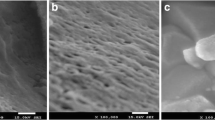Abstract
A study comparing the bioavailability of pure vs soil-adsorbed benzene was conducted in adult, male rats. Animals were gavaged with an aqueous suspension of benzene alone or adsorbed to either a Keyport series (clay soil) or a Cohansey aquifer solid (sandy soil) from New Jersey. Peak plasma concentration of radioactivity was increased in the presence of either soil vs benzene alone while the sandy soil also decreased the time to reach peak vs benzene alone. Either soil produced an increase in the area under the plasma radioactivity-time curve versus benzene alone, while the clay soil did so in a statistically significant manner. The half-life (t1/2) of absorption into plasma was not statistically different in the presence of either soil, while each soil decreased the t1/2 of elimination vs benzene alone and clay soil did so in a statistically significant manner.
Two hr after exposure, stomach tissue contained the highest amount of radioactivity followed by fat in all treatment groups. No differences were detected in the tissue concentration of radioactivity between the treatment groups.
Expired air was the primary excretion route following exposure to benzene alone with lesser amounts of radioactivity eliminated in the urine during the 48 hr following exposure. The opposite pattern was detected in the presence of clay soil, while expired air and urine represented approximately equal routes of excretion in the presence of sandy soil. Unmetabolized benzene represented the bulk of total radioactivity in the expired air of all treatment groups with [14C]O2 comprising the remainder. Less than 2% of radioactivity was eliminated by the fecal route for all treatments with significantly higher amounts in the clay soil treatment versus benzene alone.
Phenol was the primary benzene metabolite detected in the 0–12 hr urines of all treatment groups. Lesser amounts of hydroquinone, catechol, and benzenetriol were also detected. No differences in the metabolite percentages were detected between the treatment groups.
Similar content being viewed by others
References
Efron B (1982) The jackknife, the bootstrap and other resampling plans. Society Industrial Applied Math, Philadelphia, PA
Efron B, Tibshirani R (1985) The bootstrap method for assessing statistical accuracy. Technical report 101, Division of Biostatistics, Standford, CA
Gibaldi M, Perrier D (1975) Pharmacokinetics. Marcel Dekker, New York, pp 281–292
Hamaker JW, Thompson JM (1972) Adsorption. In: Goring C and Hamaker J (ed) Organic chemicals in the soil environment, Vol 1. Marcel Dekker, New York, pp 49–143
Irons RD, Greenlee WF, Weirda D, Buss JS (1981) Relationship between benzene metabolism and toxicity: A proposed mechanism for the formation of reactive intermediates from polyphenol metabolites. In: Snyder R, Parke DV, Koscis JJ, Gibson GG, Jollow A (eds) Biological reactive intermediates II: Chemical mechanisms and biological effects. Plenum, New York, pp 229–243
McConnell EE, Lucier GW, Rumbaugh RC, Albro PW, Harvan DJ, Mass JR, Harris MW (1984) Dioxin in soil: Bioavailability after ingestion by rats and guinea pigs. Science 223:1077–1079
Rickert DE, Baker TS, Buss JS, Barrow CS, Irons RD (1979) Benzene disposition in the rat after exposure by inhalation. Toxicol Appl Pharmacol 49:417–423
Sandmeyer EE (1981) Aromatic hydrocarbons. In: Clayton GD, Clayton FE (ed) Patty's industrial hygiene and toxicology, Vol 2B. John Wiley & Sons, New York, pp 3253–3432
Tukey JW (1977) Exploratory data analysis. Addison Wesley, Reading, MA. pp 205–235
Umbreit TH, Hesse EJ, Gallo MA (1986) Bioavailability of dioxin in soil from a 2,4,5-T manufacturing site. Science 232:497–499
Velleman PF, Hoaglin DC (1981) Applications, basics, and computing of exploratory data analysis (ABC's of EDA). Duxbury Press, Boston, MA. pp 159–200
Author information
Authors and Affiliations
Rights and permissions
About this article
Cite this article
Turkall, R.M., Skowronski, G., Gerges, S. et al. Soil adsorption alters kinetics and bioavailability of benzene in orally exposed male rats. Arch. Environ. Contam. Toxicol. 17, 159–164 (1988). https://doi.org/10.1007/BF01056020
Received:
Revised:
Issue Date:
DOI: https://doi.org/10.1007/BF01056020




